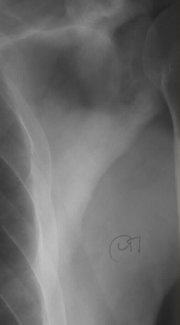Definition
Alkaline phosphatase is an enzyme found throughout the body. Like all enzymes, it is needed, in small amounts, to trigger specific chemical reactions. When it is present in large amounts, it may signify bone or liver disease or a tumor.
Purpose
Medical testing of alkaline phosphatase is concerned with the enzyme that is found in liver, bone, placenta, and intestine. In a healthy liver, fluid containing alkaline phosphate and other substances is continually drained away through the bile duct. In a diseased liver, this bile duct is often blocked, keeping fluid within the liver. Alkaline phosphatase accumulates and eventually escapes into the bloodstream.
The alkaline phosphatase of the liver is produced by the cells lining the small bile ducts (ductoles) in the liver. Its origin differs from that of other enzymes called aminotransferases. If the liver disease is primarily of an obstructive nature (cholestatic), i.e. involving the biliary drainage system, the alkaline phosphatase will be the first and foremost enzyme elevation. If, on the other hand, the disease is primarily of the liver cells (hepatocytes), the aminotransferases will rise prominently.Thus, these enzymes are very useful in distinguishing the type of liver disease -- cholestatic or hepatocellular.
Growing bones need alkaline phosphatase. Any condition of bone growth will cause alkaline phosphatase levels to rise. The condition may be normal, such as a childhood growth spurt or the healing of a broken bone; or the condition may be a disease, such as bone cancer, Paget's disease, or rickets.
During pregnancy, alkaline phosphatase is made by the placenta and leaks into the mother's bloodstream. This is normal. Some tumors, however, start production of the same kind of alkaline phosphatase produced by the placenta. These tumors are called germ cell tumors and include testicular cancer and certain brain tumors.
Alkaline phosphatase from the intestine is increased in a person with inflammatory bowel disease, such as ulcerative colitis.
Description
Alkaline phosphatase is measured by combining the person's serum with specific substances with which alkaline phosphatase is known to react. The end product of this reaction is measured; and from that measurement, the amount of alkaline phosphatase in the person's serum is determined.
Each tissue -- liver, bone, placenta, and intestine -- produces a slightly different alkaline phosphatase. These variations are called isoenzymes. In the laboratory, alkaline phosphatase is measured as the total amount or the amount of each of the the four isoenzymes. The isoenzymes react differently to heat, certain chemicals, and other processes in the laboratory. Methods to measure them separately are based on these differences.
The test is covered by insurance when medically necessary. Results are usually available the next day.
Preparation
To collect the 5-10 ml blood needed for this test, a healthcare worker ties a tourniquet on the person's upper arm, locates a vein in the inner elbow region, and inserts a needle into that vein. Vacuum action draws the blood through the needle into an attached tube. Collection of the sample takes only a few minutes.
A person being tested for alkaline phosphatase shouldn't have anything to eat or drink, except water, for eight to ten hours before the test. Some people release alkaline phosphatase from the intestine into the bloodstream after eating. This will temporarily increase the result of the test.
Aftercare
Discomfort or bruising may occur at the puncture site or the person may feel dizzy or faint. Pressure to the puncture site until the bleeding stops will reduce bruising. Warm packs to the puncture site will relieve discomfort.
Normal results
Normal results vary by age and by sex. They also vary based on the laboratory and the method used.
Abnormal results
Bone and liver disease increase alkaline phosphatase more than any other disease, up to five times the normal level. Irritable bowel disease, germ cell tumors, and infections involving the liver, such as viral hepatitis and infectious mononucleosis, increase the enzyme also, but to a lesser degree. Healing bones, pregnancy, and normal growth in children also increase levels.
Key Terms
- Alkaline phosphatase
- An enzyme found throughout the body, primarily in liver, bone, placenta, and intestine.
- Cholestatis
- Stoppage or suppression of the flow of bile.
- Enzyme
- A substance needed to trigger specific chemical reactions.
- Hepatocellular
- Of or pertaining to liver cells.
- Hepatocyte
- A liver cell.
- Isoenzyme
- A variation of an enzyme.
Further Reading
For Your Information
Books
- Fischbach, Francis. A Manual of Laboratory and Diagnostic Tests, 5th ed. Philadelphia: Lippincott, 1996, pp.382-84.
- Garza, Diana, and Kathleen Becan-MacBride. Phlebotomy Handbook, 4th ed. Stamford, CT: Appleton & Lange, 1996.
- Henry, John B., ed. Clinical Diagnosis and Management by Laboratory Methods,. 19th ed. Philadephia: W.B. Saunders Company, 1996, pp.277-78.
- Lehmann, Craig A, ed. Saunders Manual of Clinical Laboratory Science. Philadelphia: W.B. Saunders Company, 1998, pp.82-85. .
- Sacher, Ronald A., Richard A. McPherson, and J.M. Campos. "Transfusion Medicine." In Widmann's Clinical Interpretation of Laboratory Tests, 10th ed. Philadelphia: F.A. Davis, 1991, pp. 400-401.
Gale Encyclopedia of Medicine. Gale Research, 1999.



